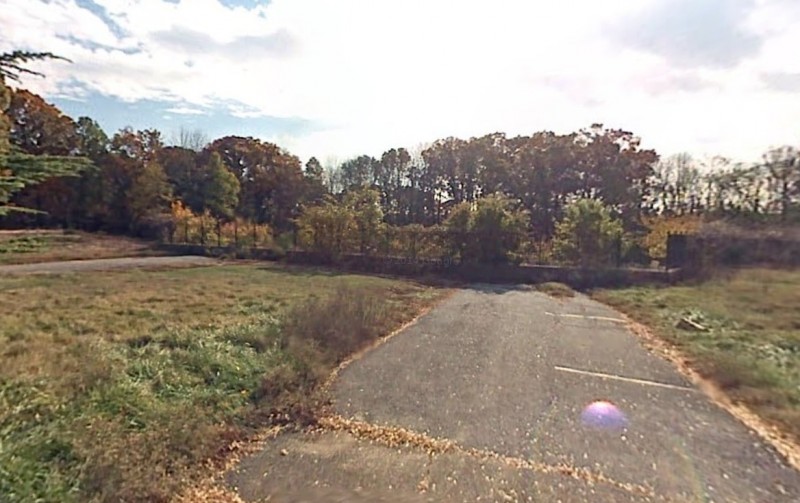Open the arboretum’s Maryland Avenue gate, says Eleanor Holmes Norton

The arboretum's Maryland Avenue gate. Image by Google.
The National Arboretum is supposed to face H Street. It sits just north of DC's Carver-Langston neighborhood, and its original main entrance was at the corner of Maryland Avenue and M Street NE, just a half-mile from The Starburst.
Eleanor Holmes Norton says it's time to reopen that gate, and once again make the arboretum work as a city park.
An inaccessible arboretum
The arboretum is one of the largest and loveliest parks in DC. It could be—should be—the Rock Creek Park of Northeast Washington, a place where residents of neighborhoods along the H Street corridor can walk to stroll surrounded by nature.
Unfortunately, since 1992 the arboretum has been, practically speaking, accessible solely via highway-oriented entrances on its far north side: one on US-50, another east of Bladensburg Road on R Street.
Existing arboretum entrances are shown in red. The proposed Maryland Avenue entrance is in blue. Base map by google. Image by the author.
A fence surrounds the rest of the arboretum, blocking access from core urban neighborhoods. For residents without cars, or even residents with cars who'd like to enjoy a park without driving to it, the arboretum may as well not exist.
The arboretum situation is similar to what was proposed in the summer of 2018 at the National Zoo, to surround the zoo with security fences and close 10 out of its 13 entrances. There, a massive outcry followed and ultimately defeated that proposal. Residents wanted to keep access to their park, and spoke out to ensure they would.
At the arboretum, that sorry situation has been a reality for 26 years. Except at the arboretum it's more like if the zoo's Connecticut Avenue and Beach Drive entrances were also closed, and the only entry was via the zoo's North Road parking lot.
Enter Eleanor to demand a fix
During a panel discussion at the arboretum last week, Congresswoman Eleanor Holmes Norton called to re-open the Maryland Avenue entrance. “Whoever heard of having a natural wonder in the middle of the city that’s closed off to the public,” she asked.
Norton's support added heft to efforts by ANC commissioners and civic associations, who have been gathering signatures and building support for the change.
The arboretum is willing, but construction is needed
Re-opening the Maryland Avenue gate is ultimately up to the arboretum's leadership. Richard Olsen, Director of the National Arboretum, says he agrees with Norton in principle and is willing to work on a solution. But the gate can't re-open right away.
Unfortunately, re-opening it isn't a matter of simply unlocking a fence. The street connecting Maryland Avenue to the arboretum's internal road network isn't all there anymore. What streets do exist are in terrible condition. And a literal concrete wall blocks the spot a connecting road would go.
Concrete blocks the Maryland Avenue gate. Image by Google.
Simply put, re-opening the gate would be a construction project. And the arbortum is not flush with construction cash.
To get it done, DC or the federal government would have to provide money. That's certainly possible, but it's not automatic and it won't happen tomorrow.
One way it might happen: If the DC Department of Transportation (DDOT) funds and builds a new portion of the Anacostia River Trail that's slated to cut just south of the Maryland Avenue gate.
DDOT is planning a trail following M Street NE. Image by DDOT.
The trail could open as soon as 2020, according to the website's timeline.
The Bladensburg gate might come first
Meanwhile, before arboretum leadership focuses on Maryland Avenue, they're prioritizing constructing another, completely different gate on Bladensburg Road about three-quarters of a mile away from the Maryland Avenue gate.
Existing and proposed arboretum entrances. Base map by google. Image by the author.
The proposed new Bladensburg gate would provide access considerably further south than the arboretum's two existing northern gates. But it would cost a lot too, and it would still be car-oriented, and it would still make for a long and inhospitable walk from Near Northeast neighborhoods. And rather than providing access into the heart of the arboretum's popular garden section—as the Maryland Avenue gate would—the Bladensburg gate would access the less-used forest section.
The Bladensburg gate would be a nice addition, but it wouldn't solve the problem Norton identifies. It wouldn't open up the park to the neighborhoods.
What's next?
During last week's panel discussion, Congresswoman Norton committed to focusing on Maryland Avenue access. “Let’s not leave this up in the air,” she said, pledging to meet with Ward 5 Councilmember Kenyan McDuffie to discuss how the idea might move forward.
That's great news. Even if it will take time and money to fix the arboretum's inaccessibility, the fact that fixing it appears increasingly to be a matter of “when” rather than “if” is wonderful progress.
Unfortunately, the dream of a fully open equivalent to Rock Creek Park, accessible from any point without a fence, formal entrance, or security checkpoint, is not on the table.
